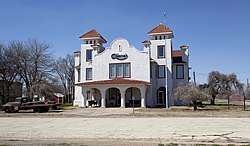Quanah, Acme and Pacific Railway
Quanah, Acme and Pacific Railway (QA&P) was a 117-mile (188 km) freight railroad that operated between the Red River and Floydada, Texas, from 1902 until it was merged into the Burlington Northern Railroad in 1981.[1]
 Former railway depot in Quanah, Texas | |
| Overview | |
|---|---|
| Dates of operation | 1902–1981 |
| Predecessor | Acme, Red River and Northern Railway |
| Successor | Burlington Northern Railroad |
History
On May 3, 1902, the line was incorporated as the Acme, Red River and Northern Railway. The founders' original, never-realized plans were to extend the line 500 miles (800 km) from the Red River to El Paso, Texas.[2]
On January 28, 1909, the railroad assumed the name of the Quanah, Acme and Pacific.[3] One of the largest shareholders was Harry Koch.[4]
In 1911, the St. Louis–San Francisco Railway assumed control of the QA&P.[2]
In 1913, the eight-mile long Motley County Railroad was chartered with money from more than ninety investors. It ran through unfenced ranch lands in Motley County before joining the QA&P at Roaring Springs. This railroad continued to operate until 1936.[5]
Freight stops on the QA&P were in the Red River, Carnes, Quanah, Acme, Lazare, Swearingen, Paducah, Narcisso, Summit (Motley County), Russellville, Roaring Springs, MacBain, Dougherty, Boothe Spur, and Floydada.
On June 8, 1981, the QA&P was merged by owner Burlington Northern Railroad, which had merged the QA&P's corporate parent, the St. Louis–San Francisco Railway, on November 21, 1980.[6]
The Burlington Northern Railroad abandoned the former QA&P line west of Paducah in 1982.[6]
Traffic
QA&P's traffic consisted of overhead freight—between the St. Louis–San Francisco Railway at the Red River and the Atchison, Topeka and Santa Fe Railway at Floydada—and some general commodities.[2] Starting in the 1960s, the QLA freight train via Floydada was scheduled to arrive Los Angeles 38½-to-40 hours after leaving Tulsa. The railroad's traffic was cut back after 1973 when overhead trade took a shorter route via Avard, OK.[7]
In 1925, QA&P reported 8 million ton-miles of revenue freight on 91 miles of line; in 1944, it had 51 million and in 1967, 130 million, both on 120 route-miles.
References
- For a general history, see Britton, Charles C., "The Quanah Route: A Texas Short Line Railroad" (1990, Joed Books, Ft. Collins, CO).
- Lewis, Edward A. (1975). American Short Line Railway Guide. The Baggage Car. p. 94.
- Lewis, Edward A. (1978). American Short Line Railway Guide. The Baggage Car. p. 103.
- Yasha Levine (2011-11-07). "Empire Building". The Texas Observer. Retrieved 2014-09-26.
- "The Motley County Railroad", Historical marker, Texas Historical Commission, Motley County, Texas
- Lewis, Edward A. (1986). American Short Line Railway Guide. Kalmbach Books. p. 233.
- Trains magazine, January 1984, p. 44.